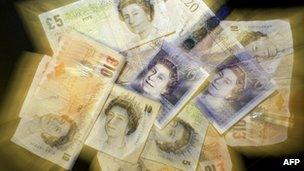Has Treasury magically cut debt by £35bn?
- Published
- comments

Here is my take on the slightly befuddling deal today between the Bank of England and the Treasury, which will see the Treasury remove supposedly surplus cash from the Bank of England's Asset Purchase Facility (APF).
The first thing to know is that the APF borrows from the Bank of England at 0.5% to purchase debt or gilts issued by the government in the famous quantitative-easing policy.
Or to put it another way, the APF has borrowed £375bn at 0.5% to effectively lend £375bn to the Treasury.
Now the Treasury pays a rather higher interest rate or coupon on that £375bn to the APF (although the Treasury can't tell me what the implicit interest rate on that £375bn is, because it is made up of lots of different loans with different maturities and different coupons).
So the APF has been making a cash profit on the difference between the interest rate it pays to the Bank of England and the interest rate it received from the Treasury.
And as of the end of March this year, that profit - called "surplus cash" by the chancellor - was £24bn. And the surplus is expected to increase by another £11bn this year.
George Osborne has decided that it is bonkers for the Treasury to borrow £11bn a year to generate spare cash that sits at the APF doing nothing.
So he has reached agreement with Sir Mervyn King, the Governor of the Bank of England, that the surplus or spare cash will be returned to the Treasury - although not all the surplus cash will come back in a single lump.
This year, the £11bn of surplus cash will not be handed to the APF. Which will mean that the government's huge debt will fall by £11bn - and the government's deficit will also fall by £11bn, if the Office for National Statistics agrees that this represents a genuine reduction in the borrowing requirement.
Next year, 2013-14, the remaining £24bn will be handed to the Treasury.
Thereafter, the Treasury will in effect pay just 0.5% interest on whatever stock of its debt is still held by the APF (if you have lost the will to live by this stage, I don't really blame you).
What does it all mean?
Well in simple terms, it means that the cost today for the government of borrowing the £375bn of debt held by the Bank of England is falling by around 3 percentage points, or roughly £11bn a year - which is a substantial saving.
But - and this is important - what we are fundamentally looking at here is a timing benefit, rather than something more fundamental. Because all that surplus cash would have been returned to the Treasury at the point that quantitative easing came to an end and the APF was wound up.
We are talking about a useful acceleration of cash flow.
That said, there may be real incremental savings to the government, if the reduction in its perceived stock of debt allows it to borrow at marginally lower interest rates. However that incremental saving is incredibly difficult to quantify.
Which is not to argue that the perception of the quantum of debt is irrelevant. One of the reasons the chancellor has made this reform is that he believes it brings the UK into line with practice in Japan and the US - whose deficits, Mr Osborne would argue, have been deflated by the fact that they don't allow their central banks to accumulate surplus cash.
What is vital to recognise is that this change should make it neither easier or harder for the Treasury to hit its target that by 2015/16 the national debt will be falling as a perecentage of GDP - because there will be a one-off reduction to the national debt in the previous year, which will have no impact on the trend between 2014/15 and 2015/16 (stay with me).
Those economists currently warning that the government will miss this important target are unlikely to change their view.
Or to put it another way, this is an immensely complicated renegotiation of a contract between the Bank of England and the Treasury whose real economic impact is fairly trivial.